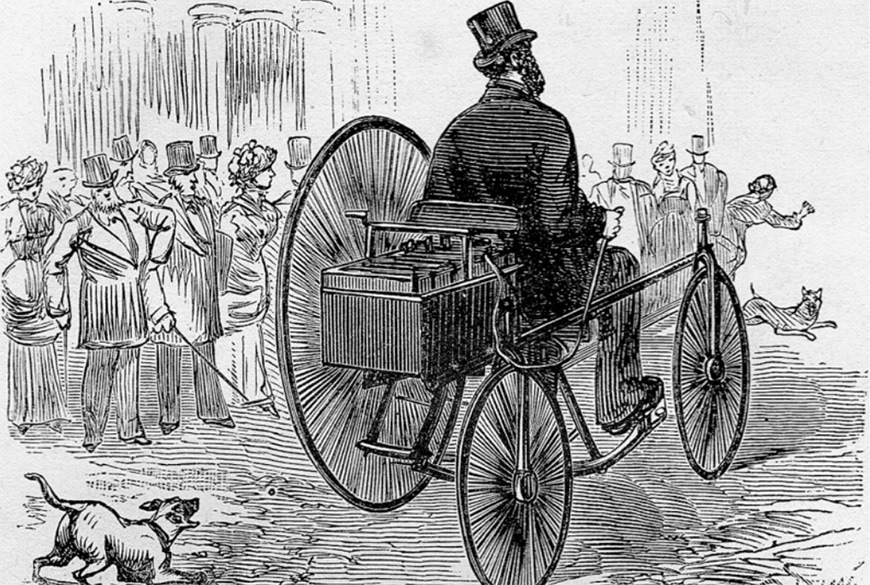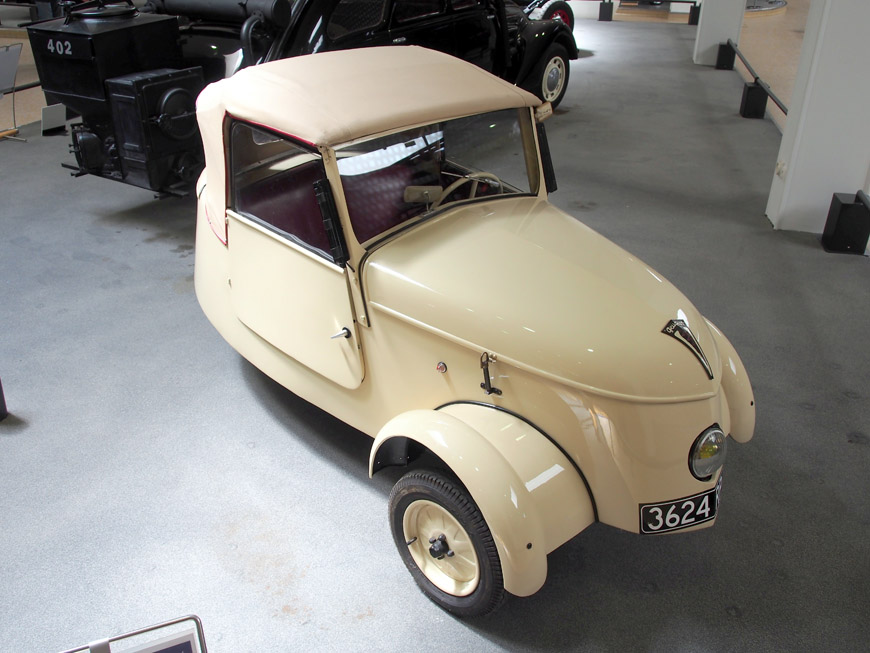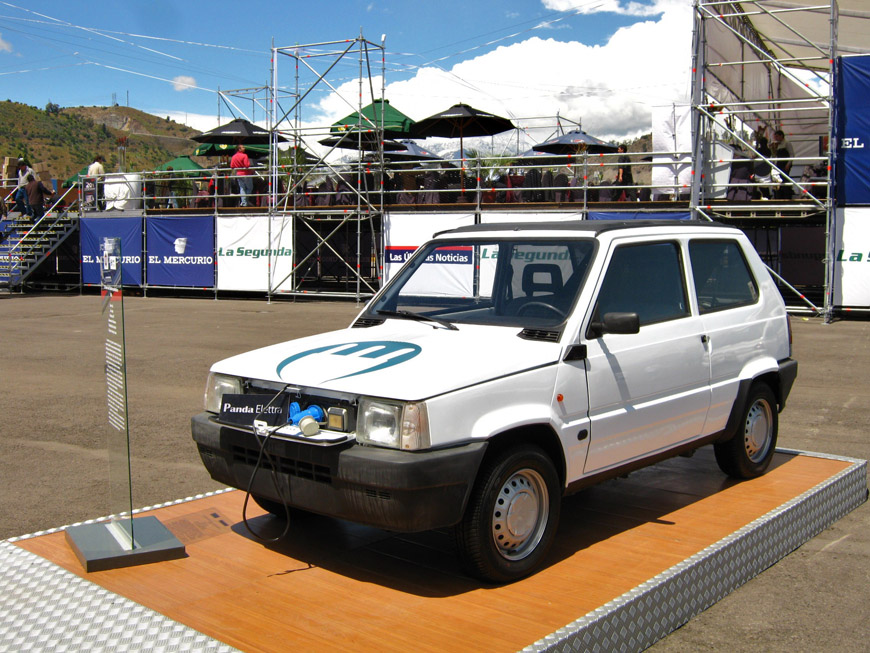Before Tesla – A brief history of the electric car
A reproduction of the 1899 “Jamais Contente” electric car in the MAUTO Automobile Museum of Turin; photo © Riccardo Bianchini / Inexhibit.
A brief history of the electric car
Humans have a short memory from time to time, and sometimes things we deem very new turn out to be much older than we think.
This also applies to the protagonist of the next revolution in transport: the electric car.
It seems normal today to consider a Tesla Model Y or a Porsche Taycan as the vanguards of a new era that will forever bury the dying age of the internal combustion engine. Still, perhaps we should look at things differently.
Not because the age of combustion engine cars will last forever, but because electric cars came before piston engine ones. If the first practical car with an internal combustion engine was built by Carl Benz in 1885, the first electric car was presented by French engineer Gustave Trouvé four years earlier. It looks like we are meeting an old friend rather than welcoming a new baby.
Thus, I have written down a brief history of the electric car starting with the first one, a legendary tricycle created in France in 1881.
Gustave Trouvé’s trycicle – France, 1881
Widely considered the first practical electric car in history, this vehicle was built by French inventor Gustave Trouvé who fitted an electric motor into a tricycle produced by British engineer James Starley. The car was also equipped with a pack of lead-acid batteries placed in a box just behind the driver’s seat.
An etching depicting Gustave Trouvé’s electric tricycle; image Jacques Cattelin CC BY-SA 4.0 via Wikimedia Commons.
Jamais Contente – France, 1899
A single-seater car with a peculiar torpedo shape, the Jamais Contente (Never Satisfied), built in France by the Belgian Camille Jénatzy in 1899, was the first car (of all types, not just electric) to go over 100 km/h. Made of wood, steel, and aluminum alloy, with a total weight of 1450 kg half of which of batteries, the car was powered by two 25 kW – 200V electric motors that pushed it to a top speed of 106 km/h.
Weight: 1,450 kg – 3,197 bs
Max power: 50 kW
Top speed: 106 km/h – 66 mph
Range: Unknown
The Jamais Contente in December 2019 at the exhibition of old cars at the Château de Compiègne. Photo by Mgiallu CC BY-SA 4.0 via Wikimedia Commons.
Studebaker Electric – USA, 1902
Studebaker Electric was a battery-powered electric car, manufactured by Studebaker Brothers between 1902 and 1912. Produced with various bodies, the vehicle was powered by an 8-volt Westinghouse motor and reached a top speed of 34 km/h.
Weight: various, depending on the body model
Max power: unknown
Top speed: 34 km/h – 21 mph
Range: 112 km – 70 mi
L’oeuf électrique – France, 1942
The Oeuf électrique (Electric egg) was a compact car built by French designer Paul Arzens in the early-1940s. Made of aluminum and acrylic glass, this futuristic two-seat balloon-shaped vehicle was powered by an electric motor with five12 volts/250 Ah batteries and reached a top speed of 70 km/h with a range of 100 kilometers.
Weight: 350 kg – 771 lbs
Max Power: ca. 6 kW (estimated)
Top speed: 70 km/h – 43 mph
Range: 100 km – 62 mi
The Electric Egg, from the Schlumpf collection of the Cité de l’Automobile in Mulhouse, Alsace. Photo by Rob Oo CC BY 2.0 via Wikimedia Commons.
Peugeot VLV – France, 1942
Roughly in the same years in which Paul Arzens was creating its Oeuf électrique, French car manufacturer Peugeot was developing another electric city car. Named VLV (Voiture Légère de Ville), it had four wheels but the rear ones were so close that the car looked like a reverse tricycle. Powered by four 12V batteries, the VLV could reach a speed of 36 km/h; only 377 VLVs were sold before Peugeot stopped manufacturing the car in 1945.
Weight: 350 kg – 771 lbs
Max power: 3,9 kW (82A x 48V)
Top Speed: 36 km/h – 22 mph
Range: 80 km – 50 mi
Peugeot VLV photographed at the Musée de l’Aventure Peugeot-Sochaux, France. Photo Alf van Beem CC0 1.0 via Wikimedia Commons.
Panda Elettra – Italy, 1990
Presented in 1990 by Fiat in collaboration with Steyr-Puch, the Panda Elettra was the first electric car produced in numbers by a major manufacturer. The Elettra was powered by a 9.2 kW DC electric motor (later upgraded to 17.7 kW) and twelve 6V lead-acid batteries (which replaced the rear seats of the petrol version) and it reached a top speed of 70 km/h with a range of 100 km. It was an ideal city car, well ahead of its time. Perhaps too ahead; in fact, the then prohibitive price of 25,600,000 lire (over 30,000 in today’s dollars; at the time, the Panda Elettra’s was higher than that of a BMW 316i) undermined its diffusion and success.
Weight: 1,220 kg – 2,690 lbs
Max power: 17.7 kW
Top speed: 0 km/h – 43 mph
Range: 100 km – 62 mi
A Fiat Panda Elettra 1990 on display at the 2010 Santiago Motorshow. Photo by Viva Chile CC BY-SA 3.0 via Wikimedia Commons.
General Motors EV1 / Impact – USA, 1996
A response to the 1990 California zero-emission vehicle mandate, the General Motors EV1 was in many ways the precursor of modern electric cars. Based on the Impact concept vehicle, the EV1 was a pretty impressive electric car for the time. Under a futuristic body with a drag coefficient of 0.19, It featured a lightweight aluminum chassis, a three-phase Alternating current Induction motor, and 32 lead-acid batteries, later replaced with NiMH ones; also the digital cockpit was quite futuristic for the 1990s.
Unfortunately, GM failed to make the car profitable and stopped manufacturing it in 1999. Then, the company retired most of the vehicles (which were available only through a lease agreement) and crushed them.
Weight: 1,360 kg – 2,998 lbs
Max power: 102 kW
Top speed: 130 km/h – 80 mph (limited)
Range: 89-169 km – 55-105 mi (depending on the battery type)
General Motors EV1 A014. Photo RightBrainPhotography (Rick Rowen) CC BY-SA 2.0 via Wikimedia Commons.
copyright Inexhibit 2025 - ISSN: 2283-5474








